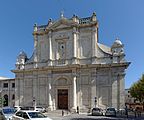L'Isle-sur-la-Sorgue
| L'Isle-sur-la-Sorgue | ||
|---|---|---|

|
|
|
| region | Provence-Alpes-Cote d'Azur | |
| Department | Vaucluse | |
| Arrondissement | Avignon | |
| Canton | L'Isle-sur-la-Sorgue ( Chef-lieu ) | |
| Community association | Pays des Sorgues et des Monts de Vaucluse | |
| Coordinates | 43 ° 55 ' N , 5 ° 3' E | |
| height | 52-246 m | |
| surface | 44.57 km 2 | |
| Residents | 19,421 (January 1, 2017) | |
| Population density | 436 inhabitants / km 2 | |
| Post Code | 84800 | |
| INSEE code | 84054 | |
| Website | www.islesurlasorgue.fr | |
 L'Isle sur la Sorgue |
||
L'Isle-sur-la-Sorgue is a French municipality with 19,421 inhabitants (at January 1, 2017) in the department of Vaucluse in the region Provence-Alpes-Cote d'Azur . Administratively, it is the seat of the canton of the same name in the Arrondissement of Avignon .
geography
L'Isle-sur-la-Sorgue is located between Avignon and the northern Luberon Valley, just a few kilometers from Fontaine-de-Vaucluse . The municipality includes the three hamlets of Saint-Antoine, Petit-Palais and Velorgues .
history
L'Isle-sur-la-Sorgue, formerly L'Isle en Venaissin , was originally a fishing town due to its proximity to the Sorgue . Called "Insula" in the Middle Ages, the place was practically on an island in the middle of a marshland that was gradually drained by the channels created. These numerous canals that surround and flow through L'Isle earned it the title of Venice des Comtat . The age of the first three canals is unknown. During the wars of religion , they made it possible for the residents to submerge the surrounding swampy landscape to such an extent that it was out of the reach of cannons .
Since the earliest times, the abundant and regulated water of the Sorgue has been driving the various machines necessary for craft and industry. The water wheels allowed the installation of grain , oil and paper mills from the 12th century , later tanneries and spinning mills for wool and silk were built . Today, little reminds of the once strong craft activities. In the 19th century there were still 62 (according to other sources 70) water wheels . L'Isle was the main wool processing center in the department.
Population development
| year | 1962 | 1968 | 1975 | 1982 | 1990 | 1999 | 2006 | 2017 |
| Residents | 8704 | 9740 | 11,508 | 12,728 | 15,564 | 16,971 | 18,015 | 19,421 |
| Sources: Cassini and INSEE | ||||||||
Attractions
The six 200-year-old wooden paddle wheels that still exist today, plus the numerous bridges over the rushing Sorgue with their wrought-iron railings, which are often surrounded by blooming flowers, characterize the streetscape of L'Isle-sur-la-Sorgue.
The old town, which all epochs left their mark on, was formerly surrounded by a city wall. The Tour d'Argent at the head of the church was built by the Counts of Toulouse in the 13th century. Not far from there, in the small streets, you can see Gothic and Renaissance facades.
The Collegiate Church of Notre-Dame-des-Anges , reconstructed in the middle of the 17th century, is an exceptional monument because of its richness of decorations inside: it is a main testimony of the Baroque in southern France and goes back to artists of the Avignon School. Since 1911 it has been under monument protection as Monument historique .
Some buildings by the architect family Brun from the 18th century can be visited. The tourist office is now located in the granary (grenier à blé) . The hospital (Hôtel Dieu) was expanded between 1749 and 1768 according to plans by Jean-Baptiste Franque . The vestibule , the pharmacy with faience from Moustiers , the chapel and in the garden a monumental fountain from 1768 are worth seeing .
Among the townhouses, for example, the classicist Hôtel Donadeï de Campredon is to be mentioned, in which first-class changing art exhibitions are presented.
The city preserves the memory of its former Jewish quarter, whose residents were protected from persecution by the popes in the Middle Ages and who played an active part in the city's growing prosperity. The city's Jewish cemetery is also protected as a monument historique .
Today L'Isle-sur-la-Sorgue has a reputation as an antiques trading center, where over 200 dealers try to sell brocantes and antiques , especially at the train station in old warehouses . During Easter and July and August, L'Isle hosts antique fairs that attract thousands.
- L'Isle-sur-la-Sorgue - Impressions
Town twinning
Sister cities of L'Isle-sur-la-Sorgue are Penicuik in Scotland and Anagni in the Italian region of Lazio.
Personalities
Born in the city
- Léopold Aimon (1779–1866), French composer
- Marie-Bernard Barnouin (1815–1888), French Cistercian abbot and founder of the monastery
- René Char (1907–1988), French poet and lyric poet
- Christiane Ziegler (* 1942), Egyptologist
Lives in the city
- Patrick Hernandez (born 1949), French singer
Web links
Individual evidence
- ↑ Monuments historiques - L'Isle-sur-la-Sorgue: Eglise paroissiale Notre-Dame-des-Anges , accessed on April 4, 2017.
- ↑ a b Michel Albarède et al .: Vaucluse (= Encyclopédies du Voyage ). Gallimard Loisirs, Paris 2007, ISBN 2-7424-1900-4 , p. 318 .
- ^ Website of the community - Jumelage , accessed on April 4, 2017





